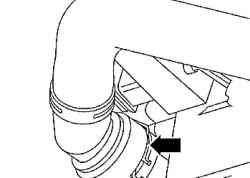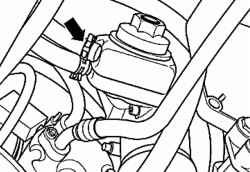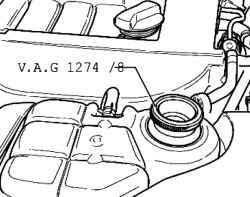 printable version printable version
Draining coolant Bay
ATTENTION When you open the expansion tank from it can go hot steam. in order to avoid eye injuries and scalding, put on goggles and special clothing. Cover bull cloth and gently open it. |
Open the expansion tank of the cooling system. Remove noise insulation.
Pull the bracket (Fig. 2.232) coolant hose down and remove the hose from the radiator.
NOTE Please dispose of the coolant. |
Additionally, to drain the coolant from the engine, disconnect the water hose from the oil cooler (Fig. 2.233).
Gulf Coolant Freezing coolant should be at least -25 ?° C (in countries with arctic climates - not less than -35 ?° C).
NOTE As the concentrate is allowed to use only G 12 plus the norm ?«TL-VW 774 F?». A characteristic feature: lilac color. G 12 plus and coolant additives marked "corresponds to TL-VW 774 F?» prevents damage from frost and corrosion, lime deposits and increases the boiling point. Therefore, throughout the year the cooling system have to work with anti-freeze and anti-corrosive concentrate. Especially in countries with a tropical climate with high loads on the engine coolant with a higher boiling point protects the engine during operation. |
It is also prohibited to reduce the proportion of concentrate in the coolant in the warm season, or when operating in countries with warm climates, adding to the cooling system water. The proportion of the concentrate should be at least 40%. If, due to climatic conditions, the freezing temperature should be reduced, it is possible to increase the share of the concentrate plus G 12, but not more than 60% (the freezing temperature in such a case would be about -40 ?° C). Beyond this limit freezing temperature to rise again and, moreover, decrease the heat capacity of the coolant. When replacing the radiator, the heat exchanger of a heater, water pump or cylinder head gasket reuse drain the coolant is prohibited. To determine the freezing temperature of the coolant is recommended to use a refractometer T10007. The number of filled coolant can vary depending on the vehicle.
Recommended mixing ratio
The order of execution of works Install the coolant hoses and secure them.
Fill the coolant using the tool for filling the cooling system VAS 6096.
| 







